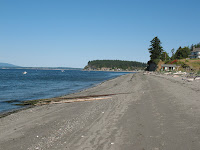 |
| Mutiny Bay Beach |
 |
| Govinda's Guillemot Tattoo |
Aldo Leopold often wrote that places must be experienced via sensory
connection in order to fully understand them. "Harmony with the land is like harmony with a friend", he once said. Similarly, within the field of geography, the
phenomenological geographers Relph and
Tuan have noted that people tend
to connect with particular ‘nodes’ in space that have meaning and significance. Using the
term ‘place’ to describe such visceral areas among spatial landscapes, these
authors have noted that places are deeply linked to life histories, social processes,
and individual experiences. In
other words, we all have special places that are richly connected to our
backgrounds, identities, and interests. Whidbey Island COASST volunteer Govinda
Rosling shared one of her special places with me today – Mutiny Bay Beach.
 |
| A Pigeon Guillemot taking flight after feeding young. |
No comments:
Post a Comment